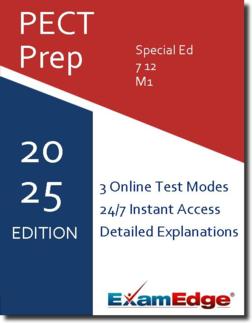PECT Special Ed 7-12 M1 ( Special Ed 7-12 M1) Practice Tests & Test Prep by Exam Edge - Test Reviews
Based on 17 Reviews
- Real Exam Simulation: Timed questions and matching content build comfort for your PECT Special Ed 7-12 M1 test day.
- Instant, 24/7 Access: Web-based PECT Special Education 7-12 Module 1 practice exams with no software needed.
- Clear Explanations: Step-by-step answers and explanations for your PECT exam to strengthen understanding.
- Boosted Confidence: Reduces anxiety and improves test-taking skills to ace your PECT Special Education 7-12 Module 1 (PSE7-12M1).

PECT Special Ed 7-12 M1 ( Special Ed 7-12 M1) Practice Tests & Test Prep by Exam Edge - Review
PECT Special Education 7-12 Module 1 - Reviews
Excellent
Based on
85
reviews
“ These practice tests have proven to be very beneficial. Not only are the tests helpful; the explanations are excellent and, to top it off, the customer service is wonderful!
Kara , Sharpsville, PA
“ I passed the PECT PREK-4 module 1 on the first try. I commend these sample tests for getting me prepared. They are great not only for practice but for content I didn't have with any other study guide. Highly recommended!
Christine , Wilkes Barre
See why our users from 154 countries love us for their exam prep! Including 17 reviews for the PECT Special Ed 7-12 M1 exam.
Exam Edge is an Industry Leader in Online Test Prep. We work with our Institutional Partners to offer a wide array of practice tests that will help you prepare for your big exam. No Matter how niche field of interest might be, were here to help you prepare for your test day.
| 2.8M | 4.5M | |
| Users | Tests Taken | |
| 100K | 19 | |
| Unique Exams | Years in Business | |


